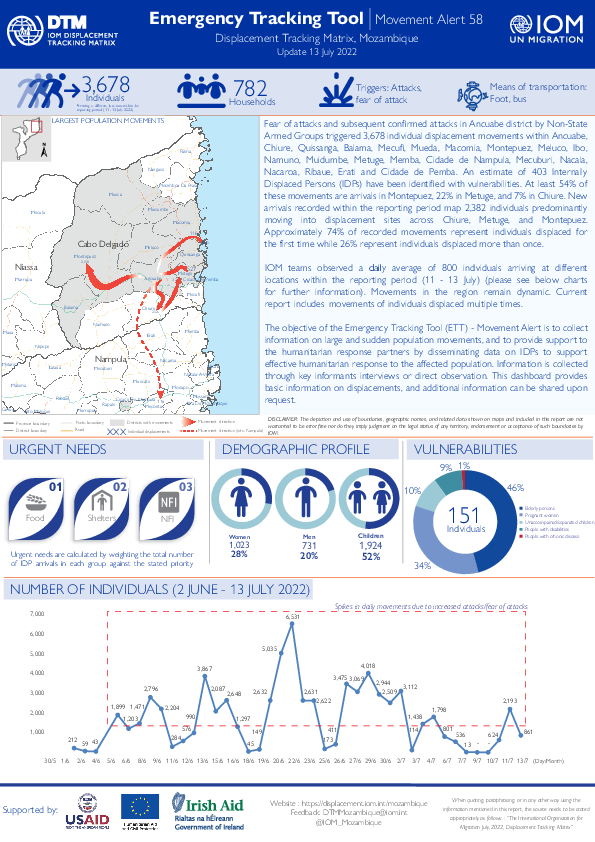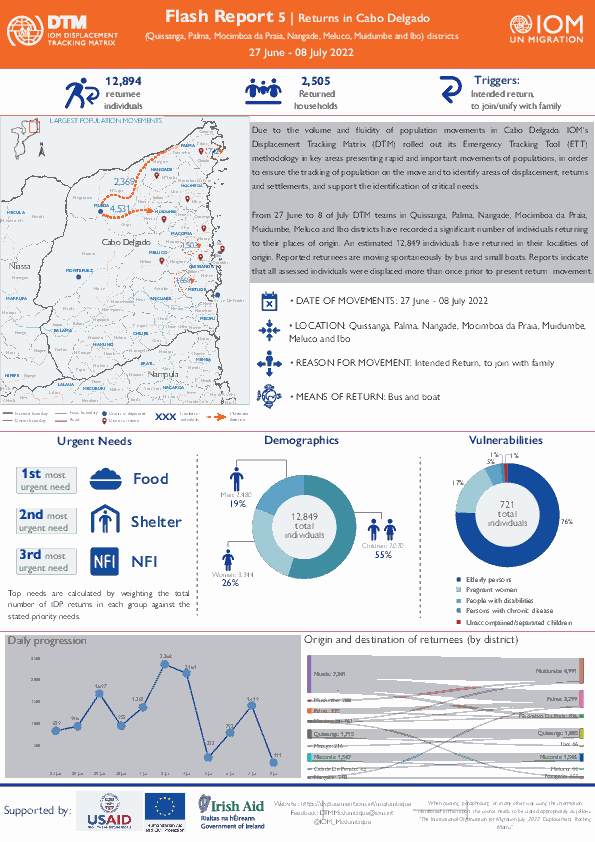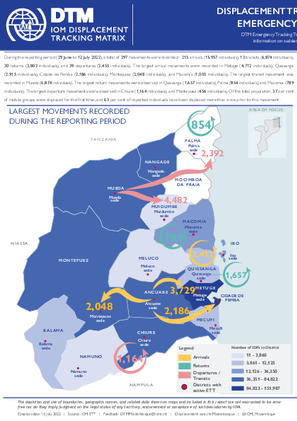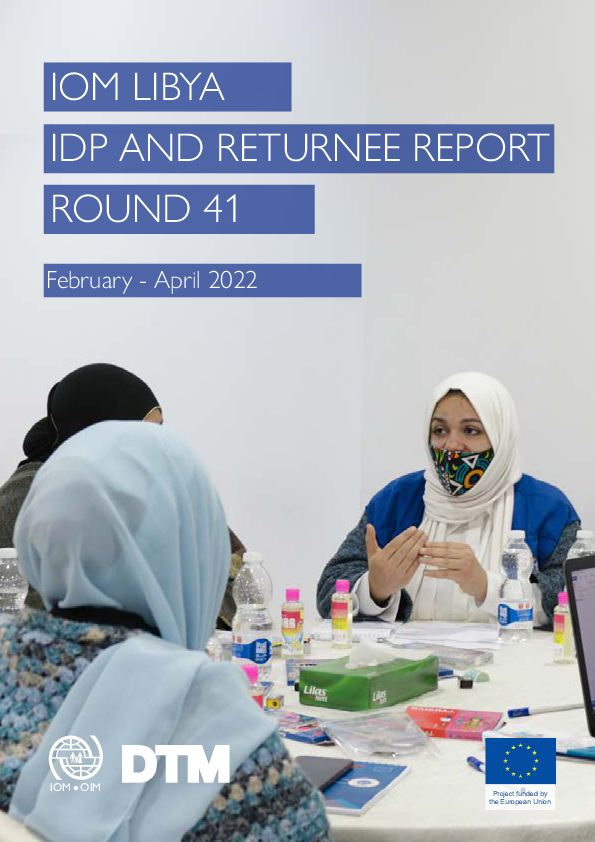-
Countries
-
Data and Analysis
-
Special Focus
-
Crisis Responses

Contact
DTM Europe, DTMMediterranean@iom.int
Language
English
Location
Slovakia
Period Covered
Mar 09 2022
Jun 30 2022
Activity
- Survey
- Return Intention
Since 24 February 2022, an increasing number of Ukrainian refugees and third-country nationals (TCNs) entering Slovakia has been registered as a result of the war in Ukraine. As of 14 July 2022, Slovak authorities have reported 603, 957 arrivals from Ukraine out of whom 561, 939 were Ukrainian refugees and 14, 686 third-country nationals (TCNs). This report is based on displacement patterns, needs and intentions survey launched by IOM Displacement Tracking Matrix (DTM). All surveys were conducted face-to-face by IOM Slovakia trained enumerators with Ukrainian refugees and TCNs fleeing Ukraine. This report presents a short analysis based on 1,027 surveys collected between 9 March and 30 June 2022.

Contact
DTMUkraine@iom.int
Language
English
Location
Ukraine
Period Covered
Jun 27 2022
Jul 08 2022
Activity
- Baseline Assessment
Starting on 24 February 2022, the war in Ukraine triggered an unprecedented humanitarian crisis across the country. Between 27 June and 8 July the International Organization for Migration (IOM) conducted an area baseline assessment of 879 hromadas hosting IDPs in Kyivska, Dnipropetrovska, Poltavska, Vinnytska, Zakarpatska, Cherkaska, Lvivska, Khmelnytska, Ivano-Frankivska, Ternopilska, Odeska, Kirovohradska, Chernivetska, Zhytomyrska, Zaporizka, Chernihivska, Volynska, Rivnenska and Sumska oblasts in order to gather initial trends on the number and geographic location of officially recorded internally displaced persons.
This routine assessment supports the targeting and provision of humanitarian assistance to the affected population and serves as a preliminary source to identify oblasts and hromadas hosting high numbers of IDPs.
IOM compiled information on more than 2,300,000 IDPs in the 19 oblasts covered by Round 7 of DTM Area Baseline. Kyivska, Dnipropetrovska and Poltavska oblasts have the highest number of displaced, each hosting over 190,000 IDPs.

Contact
DTMUkraine@iom.int
Language
Ukrainian
Location
Ukraine
Period Covered
Jun 27 2022
Jul 08 2022
Activity
- Baseline Assessment
Починаючи з 24 лютого 2022 року війна в Україні спричинила безпрецедентну гуманітарну кризу в усіх адміністративних підрозділах (областях) країни.
З 27-го червня по 8 липня Міжнародна організація з міграції (МОМ) провела базову оцінку території 879 громад, які приймають зареєстрованих внутрішньо переміщених осіб у Закарпатській, Львівській, Івано―Франківській, Черкаській., Чернівецькій, Чернігівській, Хмельницькій, Волинській, Вінницькій, Сумській, Рівненській, Житомирській, Кіровоградській, Запорізькій, Полтавській, Одеській, Тернопільській, Дніпропетровській та Київській областях, щоб отримати початкове уявлення про внутрішнє переміщення.
Проведення цієї рутинної оцінки підтримує цільове призначення та надання гуманітарної допомоги постраждалим населенням і служить попереднім джерелом для виявлення громад з високим рівнем переміщення.

Contact
iomisbdtmremapteam@iom.int
Language
English
Location
Pakistan
Period Covered
Jan 01 2021
Dec 31 2021
Activity
- Flow Monitoring
This yearly summary report, in addition to bi-weekly and quarterly reports, aims to contribute to a better understanding of return movements of undocumented Afghan returnees by conducting more in-depth analysis on the data that was collected in 2021.
The analysis of the data indicates that the number of returnees has increased more than four times as compared to 2020. However, the number of returns in 2021 could have been higher especially if the Chaman border had not been closed due to security reasons in Afghanistan. Numbers of returns were six times higher in months when the border was open (November and December), compared to when the border was closed (October). In general, in 2021, the steep increase in return movements is attributed to the relaxation of border restrictions, even during different COVID-19 waves, which allowed people to more easily cross the border as compared to the previous year.

Contact
DTMMozambique@iom.int
Language
English
Location
Mozambique
Period Covered
Jul 11 2022
Jul 13 2022
Activity
- Mobility Tracking
- Event Tracking
Fear of attacks and subsequent confirmed attacks in Ancuabe district by Non-State Armed Groups triggered 3,678 individual displacement movements within Ancuabe, Chiure, Quissanga, Balama, Mecufi, Mueda, Macomia, Montepuez, Meluco, Ibo,
Namuno, Muidumbe, Metuge, Memba, Cidade de Nampula, Mecuburi, Nacala, Nacaroa, Ribaue, Erati and Cidade de Pemba. An estimate of 403 Internally Displaced Persons (IDPs) have been identified with vulnerabilities. At least 54% of these movements are arrivals in Montepuez, 22% in Metuge, and 7% in Chiure. New arrivals recorded within the reporting period map 2,382 individuals predominantly moving into displacement sites across Chiure, Metuge, and Montepuez. Approximately 74% of recorded movements represent individuals displaced for the first time while 26% represent individuals displaced more than once.
IOM teams observed a daily average of 800 individuals arriving at different locations within the reporting period (11 - 13 July) (please see below charts for further information). Movements in the region remain dynamic. Current report includes movements of individuals displaced multiple times. The objective of the Emergency Tracking Tool (ETT) - Movement Alert is to collect information on large and sudden population movements, and to provide support to the humanitarian response partners by disseminating data on IDPs to support effective humanitarian response to the affected population. Information is collected through key informants interviews or direct observation. This dashboard provides basic information on displacements, and additional information can be shared upon request.

Contact
DTM Mozambique, DTMMozambique@iom.int
Language
English
Location
Mozambique
Period Covered
Jun 27 2022
Jul 08 2022
Activity
- Other
- Event Tracking
Due to the volume and fluidity of population movements in Cabo Delgado. IOM's Displacement Tracking Matrix (DTM) rolled out its Emergency Tracking Tool (ETT) methodology in key areas presenting rapid and important movements of populations, in order to ensure the tracking of population on the move and to identify areas of displacement, returns and settlements, and support the identification of critical needs.
From 27 June to 8 of July DTM teams in Quissanga, Palma, Nangade, Mocimboa da Praia, Muidumbe, Meluco and Ibo districts have recorded a significant number of individuals returning to their places of origin. An estimated 12,849 individuals have returned in their localities of origin. Reported returnees are moving spontaneously by bus and small boats. Reports indicate that all assessed individuals were displaced more than once prior to present return movement.

Contact
DTMMozambique@iom.int
Language
English
Location
Mozambique
Period Covered
Jun 29 2022
Jul 12 2022
Activity
- Mobility Tracking
- Event Tracking
During the reporting period (29 June to 12 July 2022), a total of 297 movements were recorded - 215 arrivals (15,957 individuals), 13 transits (6,874 individuals), 30 returns (3,802 individuals), and 39 departures (2,455 individuals). The largest arrival movements were recorded in Metuge (4,712 individuals), Quissanga (2,915 individuals), Cidade de Pemba (2,186 individuals), Montepuez (2,048 individuals), and Macomia (1,005 individuals). The largest transit movement was recorded in Mueda (6,874 individuals). The largest return movements were observed in Quissanga (1,657 individuals), Palma (854 individuals) and Macomia (789 individuals). The largest departure movements were observed in Chiure (1,164 individuals) and Montepuez (456 individuals). Of the total population, 37 per cent of mobile groups were displaced for the first time, and 63 per cent of reported individuals have been displaced more than once prior to this movement.
Contact
DTM Nigeria, AllUsersInDTMNigeria@iom.int
Location
Nigeria
Activity
- Mobility Tracking
- Site Assessment
- Baseline Assessment
Period Covered
Feb 14 2022 -Mar 30 2022
A site assessment is a sub-component of mobility tracking. It aims to collect data on population presence, living conditions and needs in a particular displacement site or community.
Population Groups
Survey Methodology
Unit of Analysis Or Observation
Type of Survey or Assessment
Keywords
Geographical Scope
Administrative boundaries with available data
The current dataset covers the following administrative boundaries
Contact
dtmlibya@iom.int
Location
Libya
Activity
- Mobility Tracking
- Baseline Assessment
Period Covered
Feb 01 2022 -Apr 30 2022
A baseline assessment is a sub-component of mobility tracking. It aims to collect data on IDP, migrant or returnee population presence in a defined administrative area of the country.
Population Groups
Survey Methodology
Unit of Analysis Or Observation
Type of Survey or Assessment
Keywords
Geographical Scope
Administrative boundaries with available data
The current dataset covers the following administrative boundaries

Contact
DTM Libya, DTMLibya@iom.int
Language
English
Location
Libya
Period Covered
Feb 01 2022
Apr 30 2022
Activity
- Mobility Tracking
- Baseline Assessment
This IOM Displacement Tracking Matrix (DTM) report presents the data and findings on internally displaced persons (IDPs) and returnees between February 2021 – April 2022, representing round 41 of the DTM Mobility Tracking in Libya. The trend of return of IDPs to their places of origin and the resulting decrease in the number of people displaced observed since the October 2020 ceasefire continued, with 680,772 individuals previously displaced returned to their places of origin, while 159,996 IDPs still identified as displaced by end of April 2022. This accounts for a 49 per cent reduction in the number of people internally displaced in Libya since the October 2020 ceasefire (when 316,415 IDPs were reported)